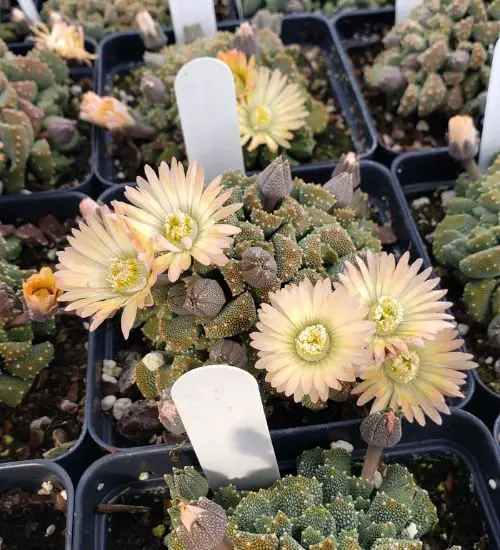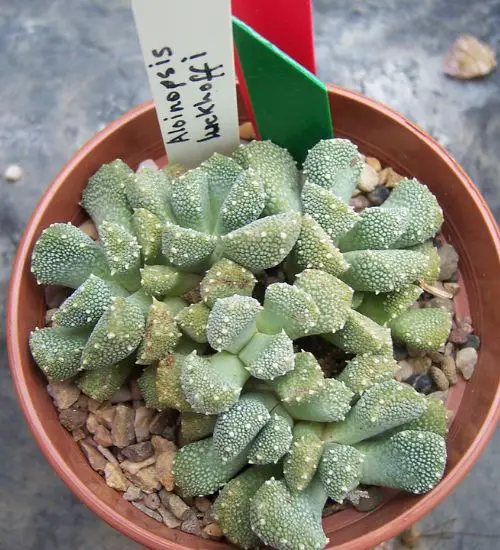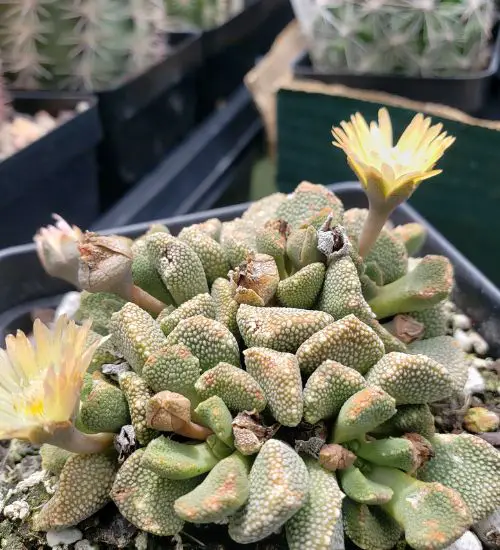Sun: Bright indoor light
Water: Typical water needs for a succulent
Temperature: Zone 8a from 10° F to 15° F (-12.2 ° C to -9.4° C) to Zone 11b from 45° F to 50° F (7.2° C to 10° C)
Winter Survival: Cold hardy
Propagation: cuttings, seeds, division
Flower: in the Winter.
Flower Type: Yellow, salmon colored
Toxic: Generally non-toxic to humans and animals
Dormant: summer
Space Requirement: Indoors & Outdoors
Common Problems: Plants may rot if overwatered, pests
Where to buy Aloinopsis luckhoffii?
Basc Care for Aloinopsis luckhoffii
Watering
Watering for Aloinopsis luckhoffii is a simple task. It requires Typical water needs for a succulent.
One simple tip for you is that you can use some online apps to check the soil status before you go water your succulents. I would recommend the ThePlantsCheck app, it has some nice features there.
Fertilizing
Only feed this succulent during its active growing seasons which means winter. Use the right fertilizer applied in the right amounts. Applying half-strength balanced fertilizer every month or so is recommended for optimal results.
Do not fertilize during summer as the plant is dormant.
Sun & Location Requirements for "Aloinopsis luckhoffii"
Aloinopsis luckhoffii needs lots of sunshine! An ideal spot is near a window that gets direct sun for a few hours every day. If you don’t have natural sunlight indoors, consider investing in an LED grow-light to provide enough light for Aloinopsis luckhoffii to stay healthy and vibrant.
As per this succulent profile, it is only able to stay healthy when the environment temperature is above the range of zone 8a from 10° F to 15° F (-12.2 ° C to -9.4° C).
Aloinopsis luckhoffii is an ideal choice for gardens in cold climates. Its thick leaves and stems help it retain moisture, and its colorful foliage adds brightness to any winter landscape. This succulent is renowned for being cold hardy and able to survive temperatures down to 0°F. With its ability to withstand frigid weather, Aloinopsis luckhoffii is the perfect addition to any frosty winter garden.
Any succulents in the group will need a medium space to grow. You can place your pot at your table or window. Since this plant needs more space than mini succulents, you should consider do not plant them together with other succulents/plants.
Aloinopsis luckhoffii also benefits from some indirect light throughout the day as well, so make sure you give it enough space to soak up light without becoming too exposed to heat.
Propagation
One way to propagate Aloinopsis luckhoffii is by cutting
Aloinopsis luckhoffii can be propagated from seeds. Signs of a good seed is one that is plump, dark in color and slightly sticky. To propagate X from seed, one must prepare a soil mixture of well-draining potting mix, sow the seeds evenly and lightly press them into the surface. Lastly, gently water the soil using a spray bottle and place the container in bright but indirect light.
Toxicity

Aloinopsis luckhoffii is generally non-toxic to humans and animals. However, it is important to be aware that certain parts of the plant may contain toxins which can cause mild skin irritation. It is advised that you keep the plants away from small children or pets, as they may unknowingly ingest them and suffer ill effects.
Pests and Diseases
Aloinopsis luckhoffii can be affected common pests and diseases like most of the other succulents such as mealybugs, scale insects, and Red spider mites.
If you do spot any of pest signs, you can treat your succulent using below methods.
- Mealybugs: quarantine, clean infected plants, soapy water.
- Scale insects: quarantine, clean infected plants, soapy water.
- Red spider mites: Quarantine, clean your infected plants, treatment with a systemic insecticidal/soapy water.
Besides that, to prevent serious health issues from happening, keep your succulent in a well-ventilated area and check it regularly for any signs of pests or health problems.


